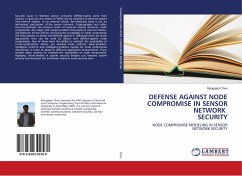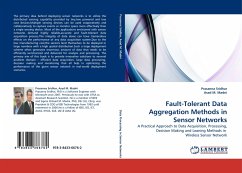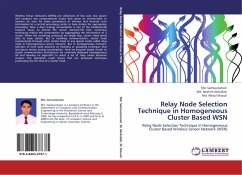
DEFENSE AGAINST NODE COMPROMISE IN SENSOR NETWORK SECURITY
NODE COMPROMISE MODELING IN SENSOR NETWORK SECURITY
Versandkostenfrei!
Versandfertig in 6-10 Tagen
32,99 €
inkl. MwSt.

PAYBACK Punkte
16 °P sammeln!
Security issues in Wireless sensor networks (WSNs) mainly come from attacks. In general, the attacks in WSNs can be classified as external attacks and internal attacks. In an external attack, the attacking node is not an authorized participant of the sensor network. Cryptography and other security methods can prevent some of external attacks. However, node compromise, the major and unique problem that leads to internal attacks, will eliminate all the efforts. Knowing the probability of node compromise will help systems to detect and defend against it. Although there are some approaches that ca...
Security issues in Wireless sensor networks (WSNs)
mainly come from attacks. In general, the attacks in
WSNs can be classified as external attacks and
internal attacks. In an external attack, the
attacking node is not an authorized participant of
the sensor network. Cryptography and other security
methods can prevent some of external attacks.
However, node compromise, the major and unique
problem that leads to internal attacks, will
eliminate all the efforts. Knowing the probability
of node compromise will help systems to detect and
defend against it. Although there are some
approaches that can be used to detect and defend
against node compromise, few of them have the
ability to estimate the probability of node
compromise. Hence, we develop basic uniform, basic
gradient, intelligent uniform and intelligent
gradient models for node compromise distribution in
order to adapt to different application
environments. These models allow systems to estimate
the probability of node compromise. Applying these
models in system security designs can improve system
security and decrease the overheads nearly in every
security area.
mainly come from attacks. In general, the attacks in
WSNs can be classified as external attacks and
internal attacks. In an external attack, the
attacking node is not an authorized participant of
the sensor network. Cryptography and other security
methods can prevent some of external attacks.
However, node compromise, the major and unique
problem that leads to internal attacks, will
eliminate all the efforts. Knowing the probability
of node compromise will help systems to detect and
defend against it. Although there are some
approaches that can be used to detect and defend
against node compromise, few of them have the
ability to estimate the probability of node
compromise. Hence, we develop basic uniform, basic
gradient, intelligent uniform and intelligent
gradient models for node compromise distribution in
order to adapt to different application
environments. These models allow systems to estimate
the probability of node compromise. Applying these
models in system security designs can improve system
security and decrease the overheads nearly in every
security area.












